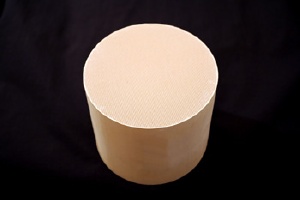Nov 16 2008
Nissan Motor Co., Ltd. announced it will introduce its ultra-low precious metal catalyst on the new Cube*1, to be launched on Nov. 19. The breakthrough catalyst, a world's first, utilizes half the amount of precious metals compared with conventional catalysts.
 Ultra-low precious metal catalyst
Ultra-low precious metal catalyst
Of the world's precious metals reserve, a high percentage of platinum (50%) and rhodium (80%) are used in the automotive industry as catalysts.
In conventional catalysts, the high temperatures within the catalyst cause the precious metals to cluster, reducing the exposed metal surface area, leading to less-effective cleaning of the emissions. To compensate, existing converters contain higher amount of precious metals in order to maintain an efficient level of cleaning.
With Nissan's pioneering technology, the precious metal attached to the substrates*2 are separated by a "wall material" which prevents clustering of the precious metals, leading to improved cleaning efficiency. Masanori Nakamura, manager of the Nissan Research Center explained the concept using the analogy of "eggs protected in a bird's nest", adding that "Nissan engineers approached the problem from a physical perspective rather than a chemical perspective in order to achieve the breakthrough."
The new under floor catalyst to be introduced in the next generation Cube uses half the amount of precious metals, from 1.3g down to .65g. Efficiency is improved with 75% less nitrogen oxides (NOx) and non-methane hydrocarbons (NMHC) emitted, lower than the Japan 2005 exhaust emission standards.
The ultra-low precious metal catalyst will be produced in Nissan's Yokohama Plant for the domestic vehicle market. This technology has been developed under the Renault-Nissan Alliance, and future applications will include Renault vehicles and diesel engines as well as potential for non-automotive application.
Under the Nissan Green Program 2010, Nissan will continue to offer advanced technologies, products and services that can lead to real-world reductions in CO2 and exhaust gas emissions.
*1: To be introduced on the Cube for Japan market.
*2: Substrate is the base which precious metals attach to in the catalyst and made from CeO2 (Cerium Oxide) etc.